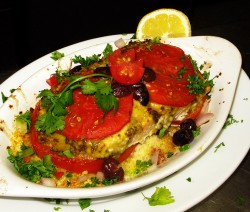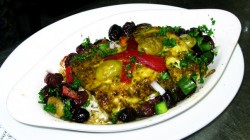A Simple Sauce For Two Different Baked Fish
I have always been partial to baked fish; ever since I made psari plaki for the first time as a poor college student in my first apartment, with fresh trout a fisherman friend had given me for free, I was hooked. I decided to make the psari plaki for the first time because there are only so many meals of breaded and fried trout one can eat, even as a penniless student. But, it being summer, with lots of fresh tomatoes to be found, along with cheap lemons, I decided to try one of the recipes in my Greek cookbook, and was glad I did.
Baking fish is a simple matter, but many things can go awry.
One can easily over-cook the fish, taking it from steamy-tender, flaky and delectable to dried-out, gummy and disgusting within the span of only a few minutes.
And that is always a shame. I so despise wasting a beautiful food like fish.
There are a few things one can do to make certain that this tragedy does not occur. The main one being of course, is to know exactly how long to cook your fish to perfection and not to deviate from that plan. Another helpful tip–under-cook your fish slightly and remove it from the oven early, then let it sit on the counter to finish cooking under its own heat while you prepare the rest of your meal. (This is the way I tend to do it–I cook the fish until it is barely done, remove it from the oven and then let it finish itself while I am busy with salads and the like.)
The fun thing about baked fish, other than its utter simplicity is that you can add so many delicious flavors to it depending on whatever sauces, aromatics, spices, vegetables and fruits you bake with it. You can completely change the character or a fish by simply changing the sauce.
Or as in the case of the two dishes shown here, you can keep the same sauce and change the vegetables that are baked with the fish.
The sauce I am presenting here is inspired by a Moroccan sauce used commonly on fish which is called chermoula. Chermoula is featured not only in the cookery of Morocco, but also Algeria and Tunisia, so as you can well imagine, there are many different interpretations of the sauce, but at its core, it is a mixture of lemon juice, olive oil, fresh herbs, garlic, salt and cumin.
The versions I have cooked and eaten at Restaurant Salaam and elsewhere usually include cilantro and perhaps parsley, with a fair amount of garlic but I determined I wanted to go in a different direction, and put the garlic front and center. I used a much greater proportion of garlic in my sauce, along with a large amount of freshly toasted cumin seeds ground finely, some Turkish kirmizi chili flakes, fresh parsley and a fair amount of harissa, the spicy roasted red pepper and chili sauce of Morocco.
Blended together in the food processor, this deep yellow sauce packs a walloping punch of flavor in each drop, but it somehow manages to stay delicate enough to enhance the delicate flavors of seafood without masking them.
As the kitchen staff at Salaam discovered, it makes an awesome dip for bread as well, as we all began snacking on the few ounces that were left the first time I used it for baking fish.
I also want to pan sear black peppercorn and coriander seed crusted lamb chops and then serve them in a pool of this liquid gold. I think that would be like eating bits of heaven right there.
But for now, let’s talk about how to use it with fish.
In the photograph above, I oiled the casserole with a bit of olive oil, then added about a half cup of cooked couscous. Then, I placed about two or three tablespoons of the prepared sauce over the couscous, then layered two thin slices of fresh local beefsteak tomato over it all. This I sprinkled with halved, pitted kalamata olives. A four ounce filet of wild-caught Alaskan salmon that had been marinated in the sauce for an hour was put on top, and then was covered with two more slices of tomato. A design of halved kalamata olives was placed on the top. This was baked in a 400 degree F. oven for about twelve to fifteen minutes, until the fish just flaked and the tomatoes were juicy and bubbly. For garnish, more minced parsley and a tomato lotus with a cilantro sprig made the baked dish look as splendid as it smelled and tasted. (We sold out of this very quickly.)
Now with in the photograph above, you see a more straightforward presentation of baked mahi-mahi using the chermoula-like sauce. Here, I marinated the fish filets for an hour in the sauce, and placed it directly above a layer of mixed pitted green and black olives. This I garnished with some slices of roasted red pepper and sliced kalamata olives.
Even though the two types of fish are quite different: salmon is oilier and more strongly flavored and mahi is a delicate, firm-fleshed white fish, they were both beautifully enhanced with this sauce. I cannot wait to try using this sauce with grilled shrimp or seared scallops!
So, without further ado, here is the recipe for a sauce which I have decided to call Sauce Salaam.
Sauce Salaam
Ingredients:
15 to 20 garlic cloves (this depends on how strong your garlic is and how big the cloves are….)
1 cup roughly chopped fresh parsley leaves
1/3 cup freshly squeezed lemon juice
1 cup peppery extra virgin olive oil
1 teaspoon cumin seeds toasted lightly in a heavy-bottomed pan and ground into a powder
1 1/2 tablespoons kirmizi or Aleppo pepper flakes
1 1/2 teaspoons harissa sauce or to taste
1/2 teaspoon sea salt
Method:
Put the garlic and parsley leaves in the bowl of a food processor and process until the two are minced finely.
Add the other ingredients and process until the oil and lemon juice are emulsified into a thick, fragrant dark yellow sauce.
(This can be kept in the refrigerator for up to a week. In addition to being tasty on fish and seafood, it makes a great dip for bread.)
No Comments yet
RSS feed for comments on this post.
Sorry, the comment form is closed at this time.
Powered by WordPress. Graphics by Zak Kramer.
Design update by Daniel Trout.
Entries and comments feeds.




